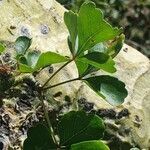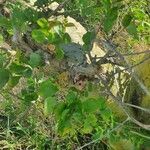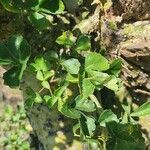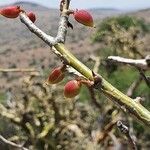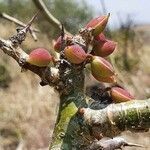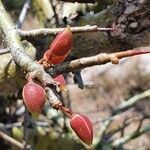Shrub or small tree 2-6 m tall; bark peeling in black discs or flaking in small yellowish papery pieces; young branchlets glabrous, spine-tipped. Leaves trifoliolate, glabrous, green; petiole 5-30 mm long; leaflets elliptic to broad elliptic; petiolules up to 2 mm long; margins coarsely crenate-serrate especially in the upper half of leaflets, apex acute, base cuneate, terminal leaflet up to 50 x 35 mm, lateral leaflets up to 25 x 22 mm. Inflorescence: flowers borne in clusters. Flowers bisexual only, hypogynous. Pedicel 1-2 mm long and with a few glandular hairs. Disc 4-lobed, not adnate to perianth. Stamens 8. Fruit ellipsoid and distinctly apiculate, ±17 x 10 x 10 mm, glabrous; putamen very rugose, pseudo-aril red, membranous, covering almost the whole putamen.
A spiny shrub. It loses is leaves. It grows 5 m high. The bark is reddish brown and peels off in rolling strips. The branches have spines at the tips. The leaves have 3 leaflets. The central leaflet is 3.5 cm long. The side leaflets are smaller. The flowers are in small clusters in the axils of leaves. They are red and cup shaped. The fruit are oval and 1.3 cm long. They split to reveal black seeds. These are surrounded by a bright red covering.
Leaves 3-foliolate; petiole up to 2·5 cm. long; terminal leaflet up to 2·6 × 1·4 cm., narrowly obovate or obovate, apex acute (often truncate to the north of our area), base gradually cuneate; lateral leaflets about half the size of the terminal ones, broadly obovate or ovate, apex acute, base broadly cuneate; margin of all leaflets coarsely crenate in the upper half.
Shrub or small tree, up to 6 m high. Branchlets spine-tipped, glabrous. Leaves 3-foliolate; leaflets glabrous, margins coarsely crenate-serrate. Fruit ellipsoid, distinctly apiculate. Pseudo-aril membranous and without arms, putamen rugose. Flowers reddish yellow.
Fruits c. 1·3 × 0·8 cm., ellipsoid to m globose, slightly apiculate at the apex; pseudaril apparently absent; endocarp c. 0·75 × 0·5 cm., ellipsoid, lumpy-rugose, with one face very deeply convex and the other shallowly so.
Shrub or small bushy tree, spiny, quite glabrous except for a few brown hairs at the apex and base of the petioles; bark smooth, peeling in yellowish strips.
Flowers appearing before the leaves in axillary abbreviated clusters, often borne on the spines; pedicels c. 1 mm. long.
Calyx 1·5 mm. long, lobed to 1/3-way or less.
Disk-lobes 4, ± bifid at the apex.
Stamen-filaments subterete.
Petals c. 3·5 mm. long.
